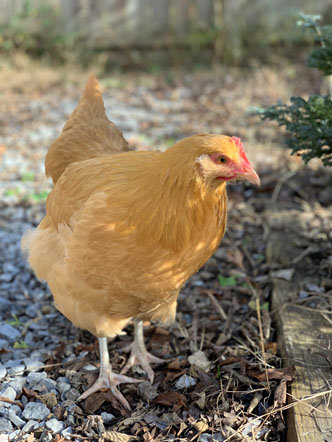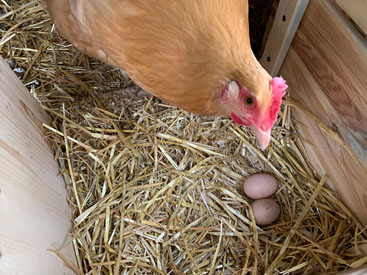Chickens provide free compost, fresh eggs, and are extremely helpful garden assistants by turning up soil, eating insects, and keeping weeds at bay. They’re part of the perfect garden trifecta: fruit and vegetables, chickens, and bees. They’re also wonderful on their own, without bees or dedicated vegetable gardens. So if you have some extra space in your backyard and live in an area where chickens are allowed, chances are you’ve contemplated getting a few birds.

But if you work long days, travel often, or otherwise don’t have much free time, the idea of keeping chickens might feel impractical or even impossible. It’s not! Low-maintenance backyard chickens are absolutely possible with just a little pre-planning and a small investment in the tools and systems that’ll maximize your effort and minimize your time.
Basic Requirements
Chickens have basic certain requirements: they must have access to fresh water, food, and supplements. They also need a clean living space, access to a run or some free range time during the day, and a securely closed coop at night. Planning a low-maintenance management strategy will limit a lot of daily chores (opening and closing coop doors) and keep your birds fed, safe, and clean.
Best Number and Breed of Chickens for You
The low-maintenance rule of thumb: less is more. Fewer chickens means lower demand for food and water, less waste in the coop, and smaller overall space requirements. Three to 4 hens are ideal. You don’t need a rooster if you just want eggs, and a lot of city regulations don’t allow them anyway because they’re LOUD. A small flock produces a dozen or so eggs a week – enough for your family – and their manure can be used in compost for your yard, or you can share it with your avid gardener friends.
Choose breeds for your small flock that’ll be productive egg layers, such as Australorps (300-plus eggs per year), Rhode Island Reds (up to 260 eggs per year), or Plymouth Rocks (up to 280 eggs per year). There are many more.
Weather
Pick breeds that have been bred for your climate and have the right temperament for a low-maintenance lifestyle. For example, if you live in an area with very cold winters, focus on cold tolerant breeds so you don’t have to worry about providing supplemental heat in the winter. Some breeds of hens will go “broody” and try to hatch their eggs even if they aren’t fertilized. Broody hens stop laying until you convince them to get off the nest, so you might want to limit breeds that are known for broodiness, such as Orpingtons, for maximum egg production from your small flock.

Chicks or No Chicks
If you decide to buy day-old chicks, taking care of them until they’re old enough to move outside is probably the most time-consuming portion of owning chickens. In addition to setting up a heated brooder space, they require daily monitoring to adjust for temperature, health, food and water. If this sounds like too much, you can often buy pullets from local farms. These hens aren’t quite old enough to lay eggs yet, but can live outside in the coop. Mind you, watching fuzzy little chicks grow into awkward teenagers offers an enjoyable and fascinating break from the rush of everyday life.
Coop Considerations
Coop size, design, and placement should be given special consideration by the would-be low-maintenance chicken keeper.
Most experts (and city regulations) recommend 2 to 3 square feet of coop space per chicken. If your birds won’t be free ranging 100 percent of the time, consider including a chicken run of 4 to 5 square feet per bird so they can move freely. Bantams, which are smaller than standard chickens, need about half as much space. It’s important that these guidelines are observed, especially if you plan to keep your chickens confined to their run most of the time and won’t be letting them free-range every day. Cramped chickens are never happy chickens. Crowding can lead to broken eggs and aggressive behavior.

Coop Design
Think carefully about coop design to make cleaning as easy and fast as possible. The ideal coop is one that sits 3 to 4 feet off the ground and has a front that opens completely. This allows you to roll a wheelbarrow underneath the opening and use a rake to get all the old bedding out in minutes. Avoid coops that have small doors, require you to crouch down, or contort yourself to clean them out. Your knees will thank you. Also, plan to cover the floor of the coop with something easy to clean such as peel-and-stick tile flooring or sheet linoleum. Over time, this will protect the wood flooring from absorbing ammonia from waste, and make cleaning easier since bedding and chicken waste won’t stick. Once every 6 to 12 months, plan to do a deep clean of the coop, giving the flooring a good scrubbing and letting everything air out.

In-progress photo of this custom-built coop shows a raised design and a fully-opening front, both of which help make cleaning out the old bedding fast and easy.
Choose the right spot for your coop. Place it in an area that’s weather appropriate: shady if you have hot summers, or sheltered if you have cold winters. Though not required, you might consider adding a rain barrel watering system, so a spot near an existing gutter can be useful.
Food and Water in Bulk
Feeding and watering chickens can be a daily chore, but it’s also one of the easiest things to make low-maintenance. Simply provide food and water in bulk.
The Feed
Three homemade PVC feeder tubes attached to the coop/run are ideal, and can be easily built with a couple of 3-inch pipes cut to 3 or 4 feet long, some elbow joints, and pipe caps to protect the feed from rain. Install the feeders through the screen of your coop and they’ll keep the food safe from squirrels and other critters while remaining accessible to your chickens, even in bad weather. Use two feeders for chicken feed; each can easily store 20 pounds or more. Use the third one for a mix of grit and oyster shell. This setup will comfortably feed a flock of 3 to 4 for several weeks, or even longer if they’re occasionally free ranging.

Build these DIY feeders to provide several weeks’ worth of food for your chickens, along with grit and a source of calcium.
Read Liz Fulghum’s article about how to Build Your Own Low-Maintenance Food and Water System
The Water
A rain barrel hooked up to a gutter and equipped with a homemade PVC/poultry nipple water dispenser is a pretty reliable source of water for your flock in most environment. Self-replenishing most of the year with regular rain and less likely to freeze in the winter, it makes for an extremely sound, hands-off watering system that your birds will love. If your coop has a nicely sloped roof, attach a gutter and barrel to catch the rain runoff, or position your coop near a gutter on your house, shed, or barn.
In very cold weather, you’ll have to check the water supply daily to make sure it’s not frozen and provide a fresh source if it is. But if you happen to have access to power, there are several ways to heat your water on those very cold days.
Automatic Coop Door for Easy Access
An automatic coop door might seem like a luxury purchase, but it’s essential for hands-off management of your chickens.
Once they’ve reached a certain age, most chickens will happily tuck themselves into their coop at night, with the door closed to ensure their safety from predators. Automatic coop doors operate on either timers or light sensors, and most complete kits retail from $200 to $300. Alternatively, you can just purchase the mechanism and attach it to a door you build.
Deep Litter and Drop Board for Easy Coop Cleaning
If you’ve built your coop high and can slide a wheelbarrow below it to rake out old bedding, cleaning is fast and simple with the help of a garden rake. But there are two other ways you can reduce the frequency of cleanings.
Deep Litter
With a deep litter system, you’ll be taking advantage of the chemistry behind composting, just inside your coop instead of in a compost pile. The carbon-based litter (wood chips or straw are most common) mixes with the nitrogen-rich chicken manure, and your chickens aerate the whole pile. Microbes, fungi, and bacteria decompose the organic matter, and you can end up with some pretty rich compost.
Because this method requires oxygen and the right balance of moisture, make sure your coop is well ventilated, and remove any clumps of bedding that become saturated with liquid. (There’s a tipping point where there’s more waste produced than the composting process can keep up with and the system can’t be sustained.) This method works best with 6 or fewer standard-sized chickens.
Start with a 3- to 4-inch layer of pine shavings, which will start composting quickly. As the coop becomes dirty and the layer of bedding compacts, simply add a new 3- to 4-inch layer of bedding on top. These next layers can be any sort of bedding you prefer: straw, chipped leaves, grass, or more pine shavings. Be careful of fresh grass clippings, though, as they contain a lot of moisture which can lead to rotting rather than composting. Add food-grade diatomaceous earth and a coop refresher such as sweet PDZ (naturally adsorbent zeolite) with each new layer. The diatomaceous earth will help control any insects, such as mites, and the coop refresher will soak up excess moisture and help keep the fly population down. After you’ve reached a depth of 8 to 12 inches, scoop everything out except the bottom few inches (keep those to jump-start the next round), and start all over again.
Drop Board
The second way to cut down on cleanings is to build a drop or dropping board. Chickens spend most of their time at night in their coop roosting. And chickens poop at night. At lot. This means that much of the waste that winds up in your coop will land in the same spot — right underneath the roost.
A dropping board is pretty much what it sounds like: a shallow tray or piece of wood fastened right below your roost that catches all the droppings. Filled with sand or sweet PDZ, which adsorbs moisture and the odor causing ammonia, the board or tray can be easily removed and scraped clean.
Love Your Low-Maintenance Chickens

Chickens bring joy (and eggs!) to the backyard homestead.
Some people dote over their chickens and enjoy constant contact with their plummed friends. But chickens also do quite well when mostly left to their own devices, given the opportunity to free-range and the occasional treat. This means that even if your life is busy, you can still enjoy fresh eggs from your own chickens for breakfast.
Liz Fulghum is an entrepreneur and technologist who also has a passion for low-maintenance, productive gardening. Her urban backyard homestead is an oasis from busy days and home to raised vegetable beds, fruit trees and shrubs, bees, and a small flock of chickens. You can follow her on Instagram @lizfulghum.













3 Comments
It goes to beeksupply.com
That is Liz Fulghum’s business. The link now takes you to her Instagram account where you can see her pictures and a link to her bee store.
Neat!